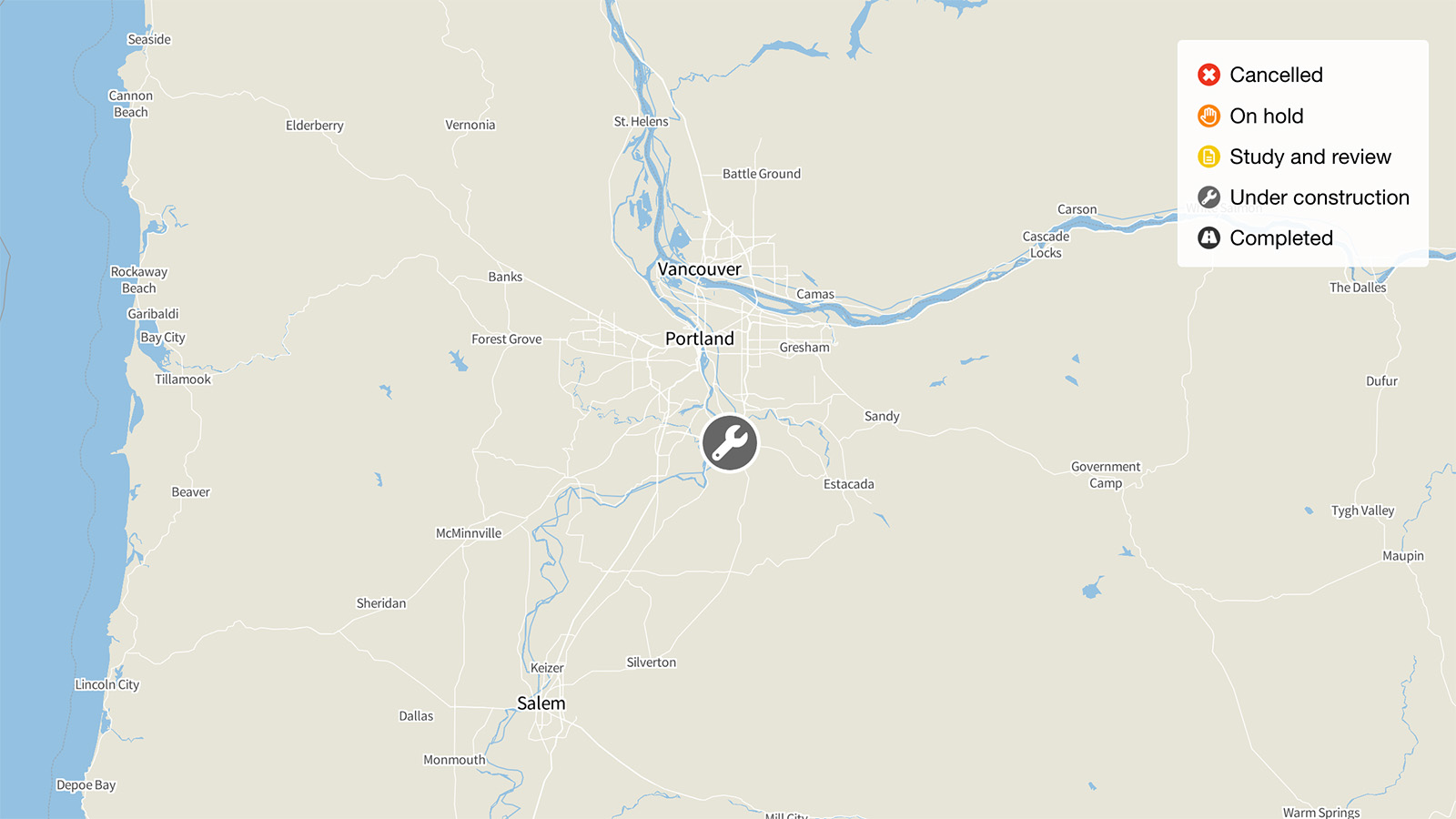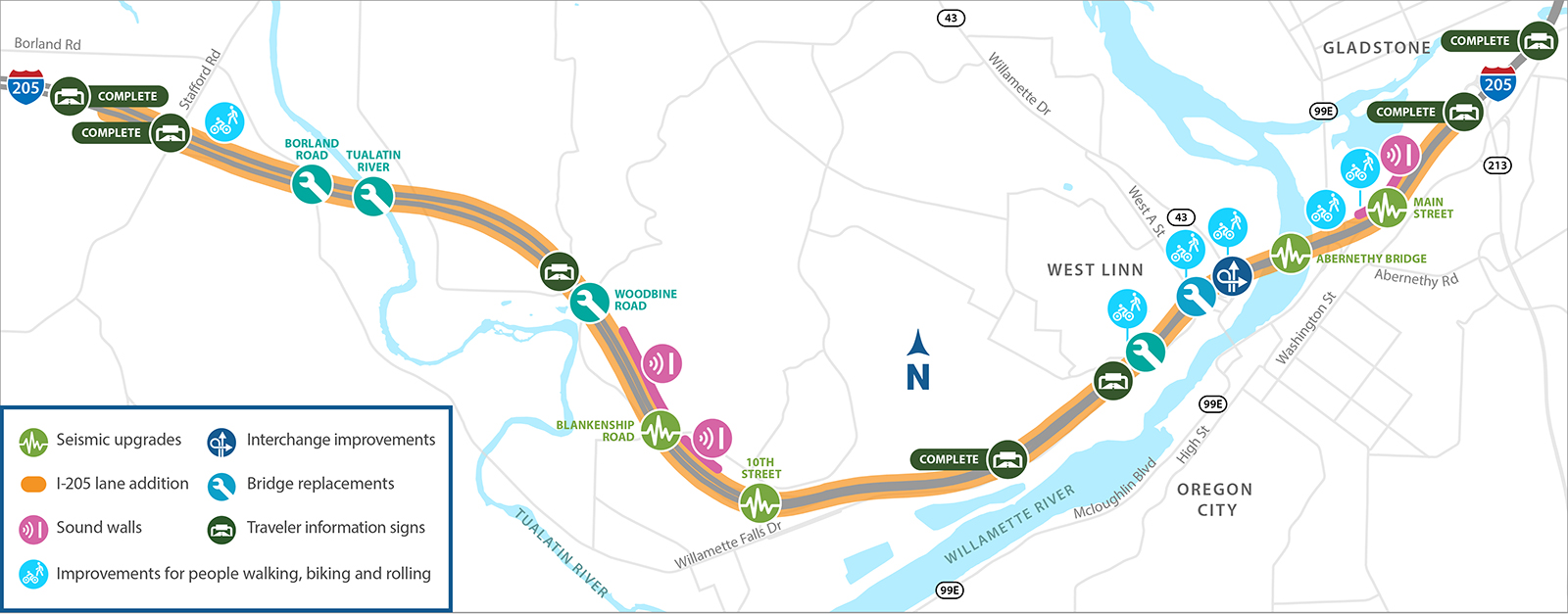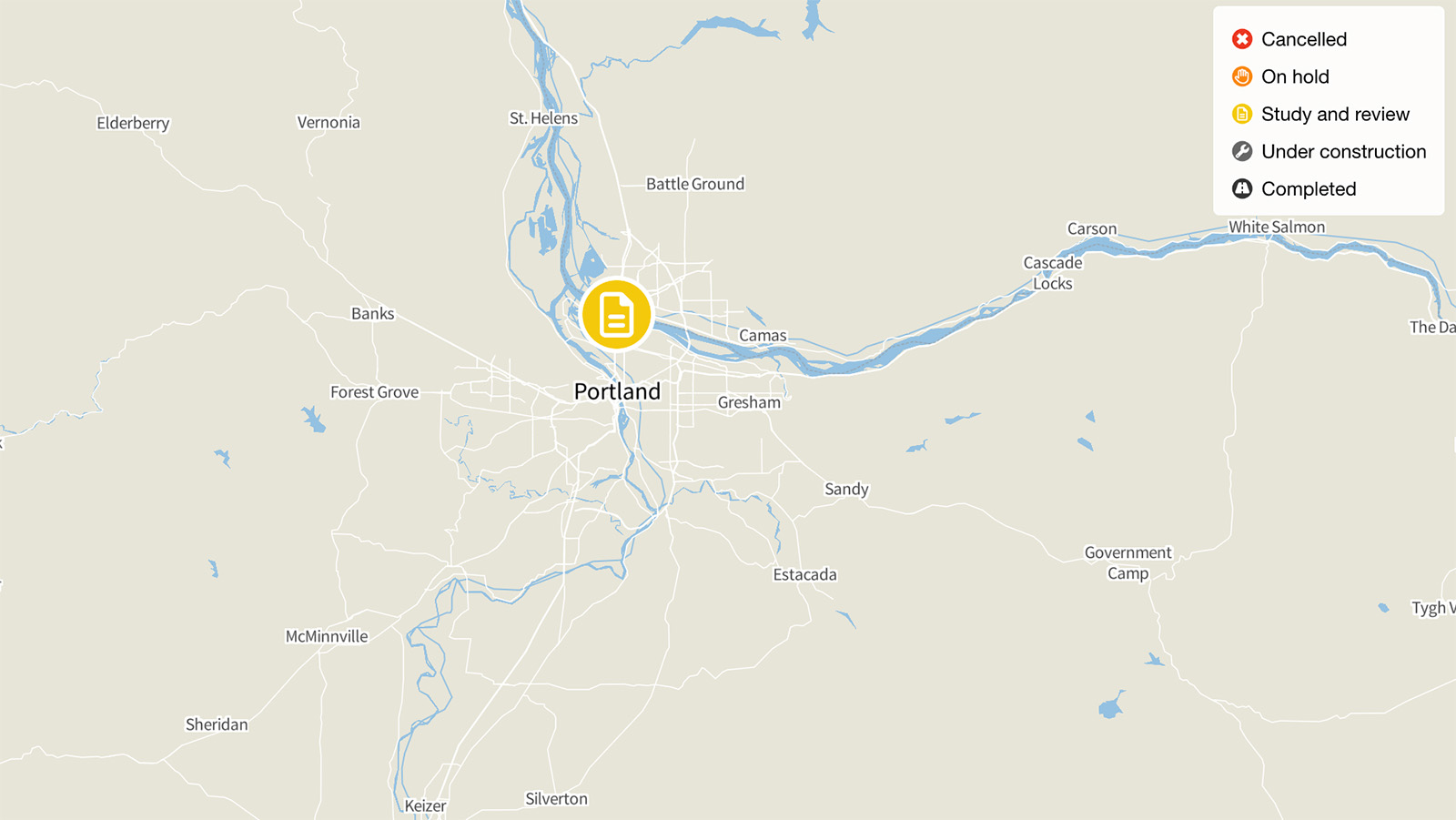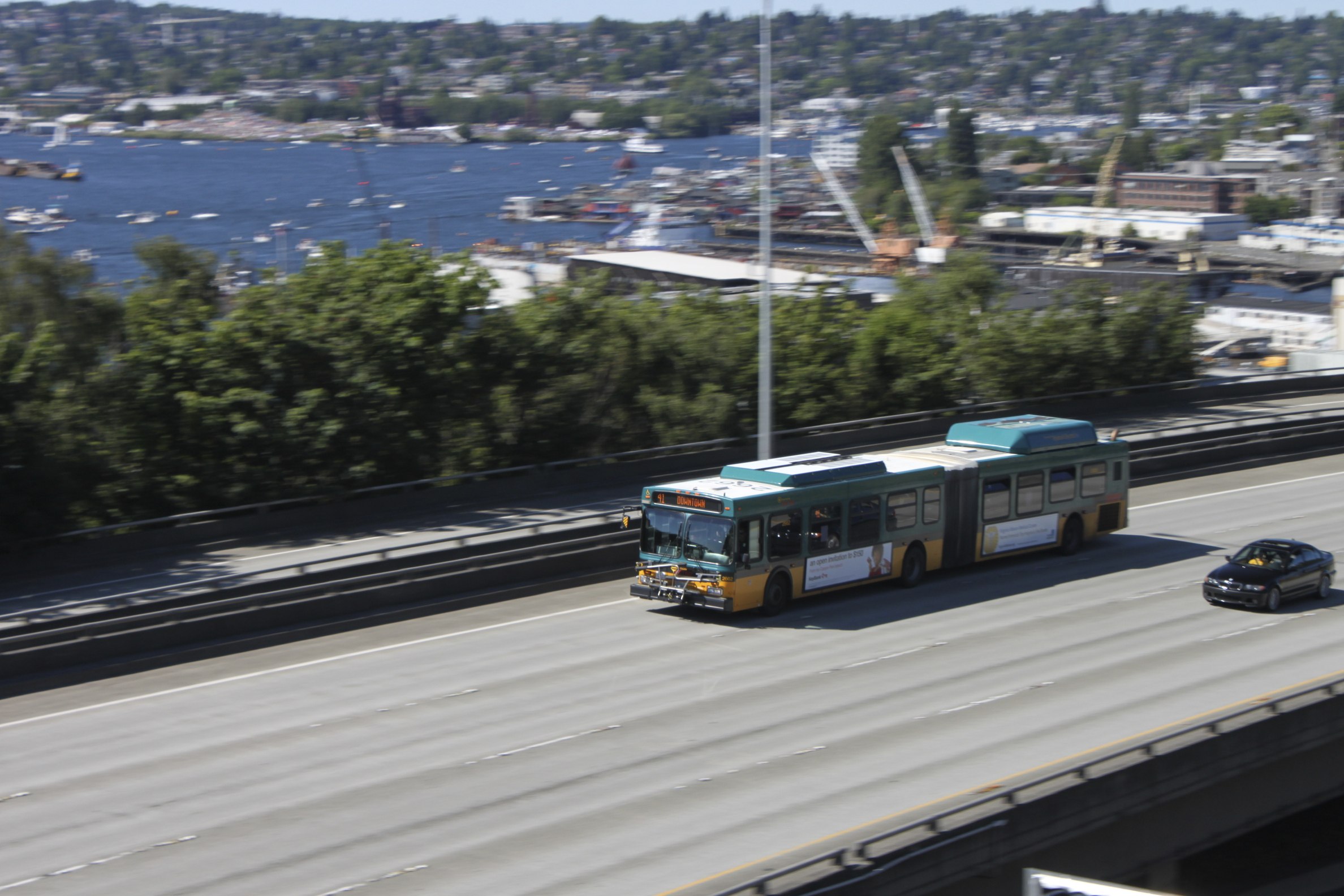
I-205 widening, Oregon

Status: Under construction
Projected cost: $900 million +
Update for current status:
As of September 2023, the I-205 widening project is currently under construction.
Original article from Highway Boondoggles 7, Fall 2022:
Every day, according to the Oregon Department of Transportation (ODOT), more than 100,000 vehicles travel the seven-mile stretch of Interstate 205 between Stafford Road and Oregon Route 213 in Oregon City – the often congested last remaining four-lane section of I-205. As part of its “I-205 Improvements Project,” the agency’s solution is to add a third lane in each direction on I-205 between Stafford Road and OR 99E, as well as a northbound entrance-to-exit lane (or “auxiliary lane”) between OR 99E and OR 213. The project as a whole encompasses a range of infrastructure upgrades, including making “earthquake-ready” a number of I-205 bridges – which in reality means demolishing and replacing multiple fully functional two-lane bridges in order to widen them to three lanes in each direction, as well as widening and significantly reconstructing the Abernethy Bridge carrying I-205 over the Willamette River.
The first phase of the I-205 project, focused on the Abernethy Bridge widening, is set to begin in 2022, having circumvented the National Environmental Policy Act (NEPA) Environmental Impact Assessment process via a documented categorical exclusion (DCE) – a feature of NEPA intended to allow agencies to bypass the requirement for full public review and environmental assessment for small, local-level actions that an agency can reasonably claim as being likely to have no significant environmental impact. It is difficult to see how the I-205 widening can be described as such, and yet the entire project – Phases 1 and 2, including the seven miles in each direction of freeway widening – was granted a DCE in December 2018, despite objectively failing to meet the requirements of categorical exclusions listed in federal regulations.

Oregon Department of Transportation’s I-205 widening program.Photo by Oregon Department of Transportation | Public Domain
ODOT has now been directed to conduct an environmental assessment to inform a federal decision on tolling. The scope of work does not appear to have changed from ODOT’s earlier position that the categorical exclusion was sufficient for covering the NEPA requirements of the widening, which it was not. The tolling assessment “builds on” the earlier DCE on the basis that “[t]he construction impacts of widening I-205 and reconstruction of the Abernethy Bridge have received environmental clearance under the DCE; therefore, the NEPA process conducted under this Task will only analyze those additional impacts that result from the tolling action.”
In May 2022, ODOT announced its intent to award the contract to build the first phase of the I-205 project to construction company Kiewit Infrastructure West.
ODOT’s plans for the I-205 project have for years been thwarted by the Oregon Legislature’s refusal to fund it, but the project has now been approved by the Oregon Transportation Commission and is being financed through the Statewide Transportation Improvement Program (STIP). Originally programmed in ODOT’s 2021-2024 STIP at $375 million, it has subsequently become clear that the project is going to be “significantly” more expensive than anticipated. The projected cost of retrofitting and widening the Abernethy Bridge – the focus of Phase 1 of the I-205 project – has already doubled: ODOT’s 2018 Cost to Complete study estimated $250 million, but when the project went to tender in the Spring of 2022, bids came back at around $500 million. ODOT’s FY22 INFRA (Infrastructure For Rebuilding America) grant application suggests that Phase 2 is projected to cost a further $453 million. If ODOT’s history of radically underestimating the actual cost of its recent highway projects is anything to go by, these numbers will most likely continue to rise.
The initial phase of the I-205 Improvements Project will be financed in part with funds approved through House Bill 3055 in the 2021 legislative session, increasing ODOT’s short-term borrowing cap from $100 million to $600 million and enabling ODOT to take out short-term debt, to be repaid primarily with toll revenue, which will ultimately be the main source of funding for the I-205 project. HB 3055 was opposed by critics who argued that the bill effectively green-lit a “freeway slush fund to write the agency a blank check to spend hundreds of millions of dollars on [freeway] widening,” authorizing ODOT to pledge not just future toll revenue, but also state gas tax revenues and future federal grants to repay the bonds. The priority for repaying bondholders also undercuts the possibility of using variable tolling primarily to manage traffic.
A 2022 City Observatory analysis argues that reliance on toll-backed bonds to fund the project – coupled with ODOT’s questionable record when it comes to accurately forecasting project costs – could endanger the financial security of the region’s transportation system and ultimately create a “huge financial liability for the state of Oregon.” If toll revenues turn out to be insufficient to pay bonds, or if project costs end up exceeding current estimates, liability for repaying these costs plus debt service on bonds will fall to the state, effectively placing the financial burden on future generations and diverting funding away from addressing actual transportation needs.
In addition, the obligation to maximize revenue in order to pay back bonds means that the state will have a perverse incentive to increase and maintain traffic on I-205, because if toll revenues fall below projections, it will have to slash other spending. This incentive to promote driving runs directly counter to the state’s adopted climate goals.
And Oregonians will get very little in return. ODOT’s own projections indicate that the addition of the new lanes in combination with tolling would mean that I-205 drivers will experience a modest shortening of their morning commutes, but that Willamette Falls and Borland roads will see no change in commute time and sections of OR 99E and OR 45 will get worse, with travel times on those roads increased by up to three minutes.
A solution to congestion on I-205 is not, as some have argued, to fund the I-205 widening using federal money rather than tolls. The addition of new lanes to I-205 will have no tangible impact on congestion, regardless of how it is funded, either on the freeway itself or on nearby local roads. And local groups have argued that there are higher priority transportation projects in this corridor that would provide residents with a greater range of mobility options and reduce carbon emissions and air pollution, including investing in transit and train services, funding the electrification of the region’s bus fleet and keeping existing roads in good repair.
Over the next five years, Oregon is set to receive a total of more than $5.4 billion in IIJA funding – including $3.4 billion from the reauthorization and increases to the federal Highway Trust Fund for highway projects and $747 million in public transit investments. As of June 2022, no IIJA money has been earmarked for the I-205 project, but the Oregon Transportation Commission is currently “evaluating the federal funds and where they might be applied.” There are plenty of ways that IIJA dollars could be put to use to bring much-needed improvements to the region’s transportation system. Widening I-205 is not one of them.
Find out more
Map credit: Map tiles by Stamen Design, under CC BY 3.0. Data by OpenStreetMap, under ODbL.
Topics
Find Out More


Interstate Bridge Replacement, Oregon and Washington

Less driving is possible

